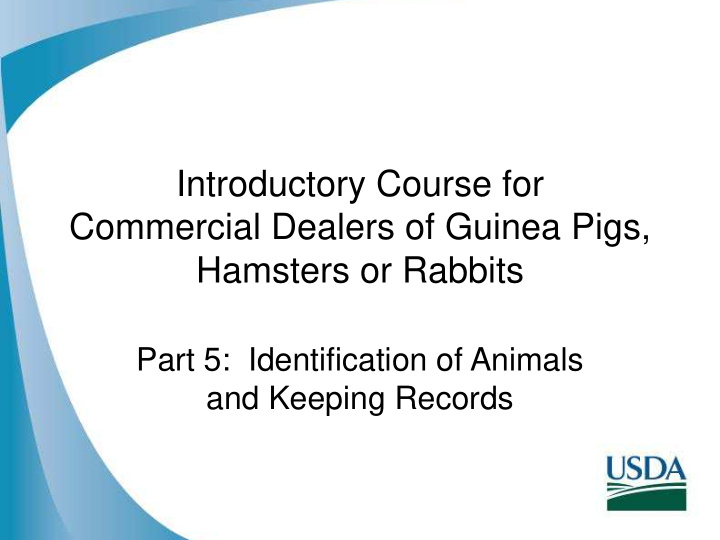



Introductory Course for Commercial Dealers of Guinea Pigs, Hamsters or Rabbits Part 5: Identification of Animals and Keeping Records
Learning Objectives By the end of this presentation you should be able to: 1. Describe approved methods for identifying guinea pigs, hamsters and rabbits 2. Explain information required in APHIS Forms 7019 and 7020 3. Describe what records need to be kept and how long they must be kept
Identification Requirements
Which Animals Require Identification? • All animals at a dealer facility must have identification including those: – Purchased, acquired, owned, held, leased or otherwise in dealer’s possession or control – Transported, sold, euthanized or otherwise disposed of – Offspring born of any animal while under dealer’s control
Types of Identification: Option 1 • Label on primary enclosure, which will include: – Number of animals – Species of animals – Any identifying marks, tattoos or tags attached to animal – Any distinctive physical features if possible
Types of Identification: Option 2 • Painted Stencil Number on primary enclosure, which will be recorded in the dealer’s records identifying: – Description of the animal(s) – Species of the animal(s) – Any distinctive physical features of the animal(s)
Types of Identification: Option 3 • Tag or Tattoo or Microchip applied to animal: – Which individually identifies each animal by description or number
Record Requirements
Recordkeeping – Purchased or – Sold or otherwise otherwise acquired disposed of – Owned – Offspring of animals in licensee’s – Held possession or control – In possession or – On premises for control breeding purposes – Transported – Personal pets housed – Euthanized at licensed facility
Completing Required Records Forms 7019, 7020, 7020A
APHIS Form 7020 1. Forms provided by APHIS include all information requirements for Licensees’ records 2. The forms are not required, but information listed in the regulations is required
Identification of Dealers
Identification of Dealers (cont’d) • Acquisition – Record type of transaction, invoice number and date – For person providing animals use 4 & 5 to record name and address and USDA license no. OR driver’s license number and state, vehicle license number, state – Use 6. and 7. to record your name and address and license number as recipient • Disposition – Record type of transaction, invoice number, and date – Use 4. and 5. to record your information as person disposing of animals – Use 6. and 7. to record applicable recipient information
Identification of Animals • Container Tag, Crate or Pen • Number of young M/F and or No. number of adults M/F • Number of animals • Estimated weights of shipment (if practical) • Previous invoice (if any) • Remarks • Individual animal – (i.e., condition, number dead, etc.) identification(If applicable) • Receiver’s use – notes • Species
Delivery Information
Delivery Receipt
APHIS Form 7019
APHIS Form 7019 • You can use either Form 7020 or 7019 to indicate acquisition or disposition of animals
APHIS Form 7019 • Identification of dealer including: – USDA license number – Name and address – Years in business – Page number of records
APHIS 7019 • Identification of animals including: – Container, tag, crate or pen number – Number of animals – Individual identification if applicable – Species – Age and sex by number of animals
APHIS Form 7019 • For each group of animals on hand, information regarding: – Date of arrival at premises – Provider including name, address, USDA license number
APHIS Form 7019 • For animals that have left the facility: – Date sold, exchanged or donated – Invoice number – Date – Date when animal died or was euthanized
Copies of Information • Record containing information required on Forms 7020, 7020A, (which is a continuation of Form 7020) and 7019 – One copy to accompany each shipment • (Source and date of acquisition not required) – One copy containing all information to be kept by dealer or exhibitor
Examples
Example: Animals on Hand • Fred Adams: – Class A license – Breeds and sells hamsters and dwarf hamsters
APHIS Form 7019
Example : Disposition of Animals • Mr. Adams sells dwarf and regular hamsters to Wayne’s Pet Dealers • He completes APHIS Form 7020 to record the transfer
Form 7020
Example: Acquisition of Animals • Wayne Smith picks up the hamsters and takes them to his facility • He notes the receipt and condition on the copy of Form 7020 that was provided to him by the seller, Fred Adams: – One hamster has died, but the others are in good condition – He accepts the shipment
Form 7020
Record Retention Requirements
How Long do I Keep Records? • One year after animal is euthanized, dies or is otherwise disposed of • Longer period if notified by the administrator
Conclusion You should now be able to explain: 1. AWA approved methods of identifying guinea pigs, hamsters or rabbits 2. Proper completion of information required and optional use of APHIS Form 7020 and 7019 3. Recordkeeping requirements under the AWA Regulations and Standards
Questions?
Acknowledgments This presentation was prepared by the Center for Food Security and Public Health, Iowa State University through a cooperative agreement with USDA APHIS Animal Care
Recommend
More recommend